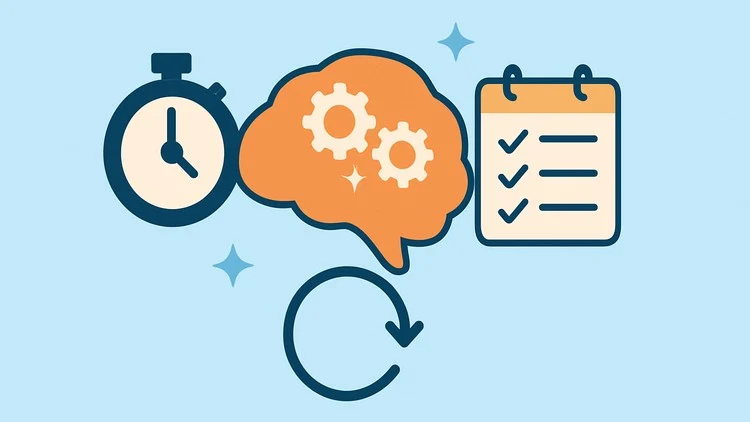We all have big goals. Maybe you want to finish a professional certification, reduce your screen time, or finally achieve a better work-life balance. These are inspiring goals — but they can also feel overwhelming. When your aim is massive, it’s easy to stall. But what if you broke those big goals down into tiny, manageable steps? That’s where micro habits come in.
Micro habits are small, consistent actions embedded into your daily routine — simple enough to do almost automatically, yet powerful enough to drive long-term transformation. These tiny routines, repeated over time, can help you build discipline, improve productivity, and create real change in your personal and professional life.
In this blog, we’ll explore what micro habits are, the science behind them, how to build them, examples you can apply right away, and strategies for sticking with them.
What Are Micro Habits?
At their core, micro habits are very small actions that serve as building blocks toward a larger ambition. Instead of trying to overhaul your life in a single leap, micro habits allow you to make steady incremental progress.
Imagine you have a goal: “I will complete two certifications this year.” Rather than diving in with massive study sessions right away, you might commit to 20 minutes of learning every day. Or, say you want to reduce your social media time — instead of dramatically cutting hours all at once, you lessen it by five minutes each day.
By shrinking your goals into manageable pieces, micro habits make the path to growth less intimidating and more consistent.
The Science Behind Micro Habits
Why do micro habits often work better than big, bold changes? The answer lies in how our brains are wired.
Neural Efficiency
Our brains form habits by building neural pathways in a region known as the basal ganglia, which handles behavior, learning, and emotion. When you repeat a behavior, the brain automates it, making it require fewer decisions. Over time, actions that once felt deliberate become automatic.Energy Conservation
Because habits reduce the need for constant decision-making, they save mental energy. This is why, according to research, a significant portion of our daily actions — between 40% and 95% — happen on autopilot.Building Through Repetition
While our conscious mind may start strong, habit formation truly takes hold through repetition — often dozens of times. Discipline matters in the early phase. Some studies suggest you might need to do an action ~ 66 times before it starts to feel automatic.Reward System Engagement
Even tiny habits can trigger dopamine release, which is our brain’s “reward chemical.” These small “wins” reinforce the behavior over time, making you more likely to continue.
Why Micro Habits Work — Benefits & Trade-offs
The Advantages
Low Friction: Since micro habits are small, it’s easy to fit them into your schedule, even on busy days.
Sustainable Motivation: Regular small rewards (like a checkmark on your tracker) keep your motivation high.
Compound Improvement: Tiny actions build up. If you improve by even 1% per day, those gains add up significantly over time.
Improved Well-Being: Micro habits help reduce stress and support health. For example, taking short micro-breaks can drastically improve focus and reduce fatigue over the long run.
One striking example: researchers asked surgeons to take 20-second micro-breaks every 20 minutes. The surgeons who followed this had seven times more accurate postoperative drawings and significantly less fatigue and pain. That’s huge considering how small the break was.
The Challenges
Of course, micro habits are not magic. They come with their own set of challenges:
Underestimation: Because they’re tiny, micro habits can feel insignificant. It’s easy to doubt their impact.
Lack of Urgency: Small habits don’t demand immediate results, so you might lose motivation if progress feels slow.
Requires Patience & Discipline: Building habits takes time, and until they become automatic, you need discipline to repeat them.
Subtlety Means Forgetting: Micro habits can be so easy to skip that without a system, they might be forgotten.

Building Micro Habits: 3-Step Plan
Let’s dive into a practical, step-by-step way to build micro habits that stick.
1. Set a Ridiculously Easy Goal
Start with something so small it’s almost silly — but crucially, it’s something you can do every single day without making excuses.
If your aim is better public speaking, plan to speak for just five minutes daily in front of a mirror.
Want to read more? Set a goal to read one page a day.
If you want to be more physically active, start by doing just 15 minutes of light exercise.
The key is to make the goal non-intimidating. When missing it feels more silly than problematic, you’re more likely to stick with it.
2. Build a Habit Loop
To make this micro habit stick, use the classic habit loop model:
Cue: A trigger that reminds you to do the habit. It could be a time of day, a preceding action, or an external signal.
Craving: The motivation or pull that makes you want to act. (Your brain might associate speaking in the mirror with building confidence, for instance.)
Response: The micro action itself (speaking, reading, exercising).
Reward: Something that gives your brain satisfaction so it reinforces the habit — maybe checking it off a list, a small treat, or simply the satisfaction of doing something.
You can anchor your cue to existing routines: for example, after brushing your teeth, you do your micro habit. This “stacking” technique helps your brain associate the cue with the new habit.
3. Reflect and Adjust Regularly
Habits don’t build themselves — you need to monitor and reflect:
Set aside a few minutes weekly to review how you’re doing: Are you consistent? Does the micro habit feel valuable?
Identify what’s working and what’s not. You may realize the cue isn’t strong enough, or the reward isn’t motivating you.
Tweak your habit loop accordingly: change the cue, adjust the reward, or even re-set the micro habit so it’s more aligned with your goals.
Reflection helps you internalize the habit and also make sure it continues to serve your larger goal.
Examples of Micro Habits You Can Try Today
Here are several micro habit examples across productivity, learning, wellbeing, and work-life balance. These are inspired by proven principles and real-world practice.
Daily Task List
Spend 1–2 minutes making a very simple to-do list for the day. Prioritize just 1–2 important tasks.
This builds structure, clarity, and momentum each morning.
Delegate One Small Task Daily
If you’re in a leadership role, pick a minor task to delegate each day.
This practice strengthens delegation skills and frees you up for more strategic work.
20 Minutes of Learning per Day
Commit to learning for exactly 20 minutes on workdays (or any schedule you can stick to).
Over weeks and months, that adds up to significant growth.
Reduce Screen Time Incrementally
Suppose social media is a distraction. Try cutting back by five minutes per day until you’re at your target.
Gradual reduction makes it much more sustainable.
Weekly Reflection
Allocate 20 minutes every week to reflect on how your habits are going.
Ask questions like: What’s working? What feels pointless? What can I improve?
Public Speaking Practice
Speak in front of a mirror for 5 minutes daily on a topic relevant to your work.
Develops comfort, clarity, and confidence in your communication.
Micro Breaks for Health
Take 20-second breaks every 20 minutes (or set another micro-break cadence).
Use the break to stretch, breathe, or reset. Research shows this can vastly improve focus and reduce physical fatigue.
Short Workout
Do 15 minutes of exercise per day. It could be stretching, a quick home workout, or yoga.
This is enough to build consistency and momentum without feeling overwhelming.
Read One Page
Read just a single page of a book daily.
This helps you build a reading habit slowly and sustainably.
Hourly Movement Reminder
If you sit for long hours, set a reminder to walk for 5 minutes every hour.
This supports physical health, breaks monotony, and offers micro-rests.
Tools & Techniques to Support Micro Habit Growth
While micro habits rely more on discipline than motivation, you don’t have to do it all in your head — you can use tools and techniques to build infrastructure around them.
Tracking Tools
Use a habit-tracking app, a simple checklist, or a calendar to mark every time you complete your micro habit. Tracking helps you visualize progress and encourages continuity.Habit Stacking
Combine micro habits: link a new tiny behavior to an existing one. For example, after boiling water for tea, you write down one thing you’re grateful for. This method, known as habit stacking, leverages your existing routines as anchors.Anchoring to Daily Anchors
Pick reliable moments in your day as anchor points: waking up, brushing your teeth, starting work, finishing a call, closing your laptop. Use them as cues to trigger your micro habit.Celebrate Small Wins
After each micro action, take a moment to acknowledge your success. Even a mental “Good job!” or checking a box gives your brain that satisfying hit of reward. These tiny reinforcements strengthen the habit loop.Patience + Reflection
Know this: micro habits don’t always deliver immediate big wins. They compound slowly. That’s why periodic reflection is key — to adjust, reinforce, and fine-tune your habits.
Overcoming Challenges & Common Pitfalls
Building micro habits isn’t always smooth sailing. Here are some common obstacles and strategies to navigate them:
Feeling Like It’s Too Small to Matter
It’s easy to dismiss micro habits because they feel insignificant. But remember: consistency compounds. Small actions today create big changes over time.
Reframe your mindset: these tiny habits are not trivial. They are strategic building blocks.
Losing Motivation
If motivation dips, rely on your system. Use tracking, reminders, and reflection to stay on course.
Revisit your “why.” Why did you start this micro habit? Re-anchoring your purpose can reignite commitment.
Not Enough Structure
Without a system, you might drop the habit. Use a habit tracker or calendar, set regular reviews, and refine your cues and rewards.
Make adjustments. If your cue no longer works (e.g., a schedule has changed), reevaluate and find a more reliable trigger.
Burnout from Too Many Habits
Resist the urge to pile on micro habits all at once. Focus on building one or two at a time until they feel automatic.
Prioritize habits that align most closely with your key goals. Start small before scaling up or adding more.
Why Micro Habits Are a Game-Changer
Here’s why micro habits are deeply powerful:
They maximize consistency over intensity. High intensity habits might fail due to burnout; micro habits win because you can always do them, no matter how busy or tired you are.
They tap into how the brain really works. Habits form through repetition and reward, not willpower. Micro habits lean into our subconscious brain’s preference for automatic behaviors.
They build long-term value. Even tiny improvements, when compounded over weeks, months, or years, lead to remarkable growth.
They reduce resistance. Because micro habits are not overwhelming, the psychological barrier to start is much lower.
Unlock Growth Through Small, Consistent Actions
Micro habits are a powerful foundation for becoming healthier, more productive, and more confident in both your personal and professional life. Start by identifying the major goals you want to achieve, then break them down into tiny actions that move you closer each day. But don’t rely on willpower alone—successful habits need a reliable system behind them.
Create a structure that helps you track your habits and review your progress regularly. As James Clear wisely notes, “The purpose of setting goals is to win the game. The purpose of building systems is to continue playing the game.”
Corexta is a leading habit and task management platform designed to help you stay consistent with your micro habits. Set goals, schedule reminders, create dashboards, customize notifications, and tailor features to suit your personal workflow. Get started for free and build the micro habits that elevate your daily productivity.
Final Thoughts
Big goals can feel intimidating. But by breaking them down into micro habits, you make growth accessible, sustainable, and even enjoyable. You’re not relying purely on motivation or willpower — you’re designing a system that works with your brain’s natural way of building habits.
Here’s a simple action you can take right now:
Choose one micro habit that aligns with a larger goal.
Define a very small version of it — something you can easily do every day.
Pick a cue (when or where you’ll do it), decide a reward, and put it into motion.
Track it daily, reflect weekly, and adjust where needed.
Over time, those tiny steps will add up. You’ll build momentum, develop positive routines, and inch closer to your big ambitions — one micro habit at a time.










